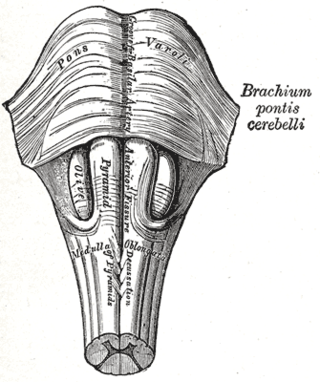Related Research Articles

The plantar reflex is a reflex elicited when the sole of the foot is stimulated with a blunt instrument. The reflex can take one of two forms. In healthy adults, the plantar reflex causes a downward response of the hallux (flexion). An upward response (extension) of the hallux is known as the Babinski response or Babinski sign, named after the neurologist Joseph Babinski. The presence of the Babinski sign can identify disease of the spinal cord and brain in adults, and also exists as a primitive reflex in infants.

Joseph Jules François Félix Babinski was a French-Polish professor of neurology. He is best known for his 1896 description of the Babinski sign, a pathological plantar reflex indicative of corticospinal tract damage.

An upper motor neuron lesion Is an injury or abnormality that occurs in the neural pathway above the anterior horn cell of the spinal cord or motor nuclei of the cranial nerves. Conversely, a lower motor neuron lesion affects nerve fibers traveling from the anterior horn of the spinal cord or the cranial motor nuclei to the relevant muscle(s).
Pyramidal signs indicate that the pyramidal tract is affected at some point in its course. Pyramidal tract dysfunction can lead to various clinical presentations such as spasticity, weakness, slowing of rapid alternating movements, hyperreflexia, and a positive Babinski sign.

Nicolas Rossolimo was a Russian Empire-born chess player. After acquiring Greek citizenship in 1929, he was able to emigrate that year to France, and was many times chess champion of Paris. In 1952 he emigrated to the United States, and won the 1955 U.S. Open Chess Championship. He was awarded the title of International Grandmaster by FIDE in 1953. Rossolimo was a resident of New York City until his death.
Primitive reflexes are reflex actions originating in the central nervous system that are exhibited by normal infants, but not neurologically intact adults, in response to particular stimuli. These reflexes are suppressed by the development of the frontal lobes as a child transitions normally into child development. These primitive reflexes are also called infantile, infant or newborn reflexes.
Hoffmann's reflex is a neurological examination finding elicited by a reflex test which can help verify the presence or absence of issues arising from the corticospinal tract. It is named after neurologist Johann Hoffmann. Usually considered a pathological reflex in a clinical setting, the Hoffmann's reflex has also been used as a measure of spinal reflex processing (adaptation) in response to exercise training.
The Chaddock reflex is a diagnostic reflex similar to the Babinski reflex. Chaddock's sign is present when stroking of the lateral malleolus causes extension of the great toe, indicating damage to the corticospinal tract.

Grigory Ivanovich Rossolimo was a Russian Empire and Soviet neurologist who was a native of Odessa. He specialized in the field of child neuropsychology.
Oppenheim's sign is dorsiflexion of the great toe elicited by irritation downward of the medial side of the tibia. It is one of a number of Babinski-like responses.The sign's presence indicates a damage to the pyramidal tract.
Bing's sign or Bing's reflex is a clinical sign in which pricking the dorsum of the foot or toe with a pin causes extension of the great toe. It is seen in patients with upper motor neuron lesion of the lower limbs. It is one of a number of Babinski-like responses.
Brissaud's reflex is a clinical sign in which stroking the sole of the foot elicits contraction of tensor fasciae latae. This can occur when there is no movement of the toes, and is part of the extensor plantar response.
Stransky's sign is a clinical sign in which vigorous abduction followed by the sudden release of the little toe causes an extensor plantar reflex. It is found in patients with pyramidal tract lesions, and is one of a number of Babinski-like responses.
Gonda's sign is a clinical sign in which flexing and then suddenly releasing the fourth toe elicits an extensor plantar reflex. It is found in patients with pyramidal tract lesions, and is one of a number of Babinski-like responses.It is named after the Ukrainian neuropsychiatrist Viktor Gonda (1889–1959), who discovered it sometime in the mid-1930s while he was practicing in the United States. Gonda was one of the strong proponents of electrotherapy to cure psychiatric illnesses.
Gordon's sign is a clinical sign in which squeezing the calf muscle elicits an extensor plantar reflex. It is found in patients with pyramidal tract lesions, and is one of a number of Babinski-like responses.
Strümpell's sign is a clinical sign in which the patient's attempt to flex the knee against resistance elicits an extensor plantar reflex. It is found in patients with pyramidal tract lesions, and is one of a number of Babinski-like responses.
Throckmorton's reflex is a clinical sign in which pressure over the dorsal side of the metatarsophalangeal joint of the big toe elicits a plantar reflex. It is found in patients with pyramidal tract lesions, and is one of a number of Babinski-like responses.
Rossolimo is a Greek last name. According to researches of Alexander N. Rossolimo, the name is widely used on the Ionian Islands and especially Kefalonia. It originates from the French baron or general Hugues de Sully who was in the service of Charles I of Naples. His red hair got de Sully the nickname Hugues le Rousseau that was mixed from Rousseau and Sully to the name Rossolimo.

Babinski–Nageotte syndrome is an alternating brainstem syndrome. It occurs when there is damage to the dorsolateral or posterior lateral medulla oblongata, likely syphilitic in origin. Hence it is also called the alternating medulla oblongata syndrome.
References
- ↑ Kumar SP, Ramasubramanian D (December 2000). "The Babinski sign--a reappraisal". Neurol India. 48 (4): 314–8. PMID 11146592 . Retrieved 2009-04-13.
- ↑ Rossolimo's reflex at Who Named It?